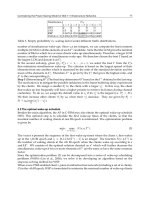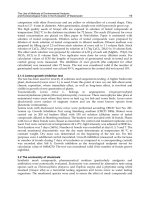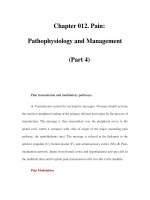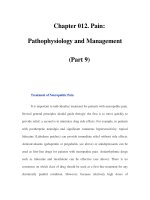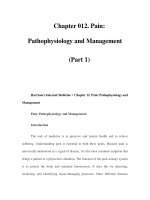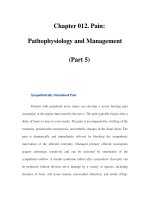Chapter 012. Pain: Pathophysiology and Management (Part 2) pot
Bạn đang xem bản rút gọn của tài liệu. Xem và tải ngay bản đầy đủ của tài liệu tại đây (308.4 KB, 5 trang )
Chapter 012. Pain:
Pathophysiology and Management
(Part 2)
Sensitization
When intense, repeated, or prolonged stimuli are applied to damaged or
inflamed tissues, the threshold for activating primary afferent nociceptors is
lowered and the frequency of firing is higher for all stimulus intensities.
Inflammatory mediators such as bradykinin, nerve growth factor, some
prostaglandins, and leukotrienes contribute to this process, which is called
sensitization. In sensitized tissues, normally innocuous stimuli can produce pain.
Sensitization is a clinically important process that contributes to tenderness,
soreness, and hyperalgesia. A striking example of sensitization is sunburned skin,
in which severe pain can be produced by a gentle slap on the back or a warm
shower.
Sensitization is of particular importance for pain and tenderness in deep
tissues. Viscera are normally relatively insensitive to noxious mechanical and
thermal stimuli, although hollow viscera do generate significant discomfort when
distended. In contrast, when affected by a disease process with an inflammatory
component, deep structures such as joints or hollow viscera characteristically
become exquisitely sensitive to mechanical stimulation.A large proportion of Aδ
and C afferents innervating viscera are completely insensitive in normal
noninjured, noninflamed tissue. That is, they cannot be activated by known
mechanical or thermal stimuli and are not spontaneously active. However, in the
presence of inflammatory mediators, these afferents become sensitive to
mechanical stimuli. Such afferents have been termed silent nociceptors, and their
characteristic properties may explain how under pathologic conditions the
relatively insensitive deep structures can become the source of severe and
debilitating pain and tenderness. Low pH, prostaglandins, leukotrienes, and other
inflammatory mediators such as bradykinin play a significant role in sensitization.
Nociceptor-Induced Inflammation
Primary afferent nociceptors also have a neuroeffector function. Most
nociceptors contain polypeptide mediators that are released from their peripheral
terminals when they are activated (Fig. 12-2). An example is substance P, an 11-
amino-acid peptide. Substance P is released from primary afferent nociceptors and
has multiple biologic activities. It is a potent vasodilator, degranulates mast cells,
is a chemoattractant for leukocytes, and increases the production and release of
inflammatory mediators. Interestingly, depletion of substance P from joints
reduces the severity of experimental arthritis. Primary afferent nociceptors are not
simply passive messengers of threats to tissue injury but also play an active role in
tissue protection through these neuroeffector
functions.
Events leading to activation, sensitization, and spread of sensitization
of primary afferent nociceptor terminals. A. Direct activation by intense
pressure and consequent cell damage. Cell damage induces lower pH (H
+
) and
leads to release of potassium (K
+
) and to synthesis of prostaglandins (PG) and
bradykinin (BK). Prostaglandins increase the sensitivity of the terminal to
bradykinin and other pain-producing substances. B. Secondary activation.
Impulses generated in the stimulated terminal propagate not only to the spinal cord
but also into other terminal branches where they induce the release of peptides,
including substance P (SP). Substance P causes vasodilation and neurogenic
edema with further accumulation of bradykinin. Substance P also causes the
release of histamine (H) from mast cells and serotonin (5HT) from platelets.
